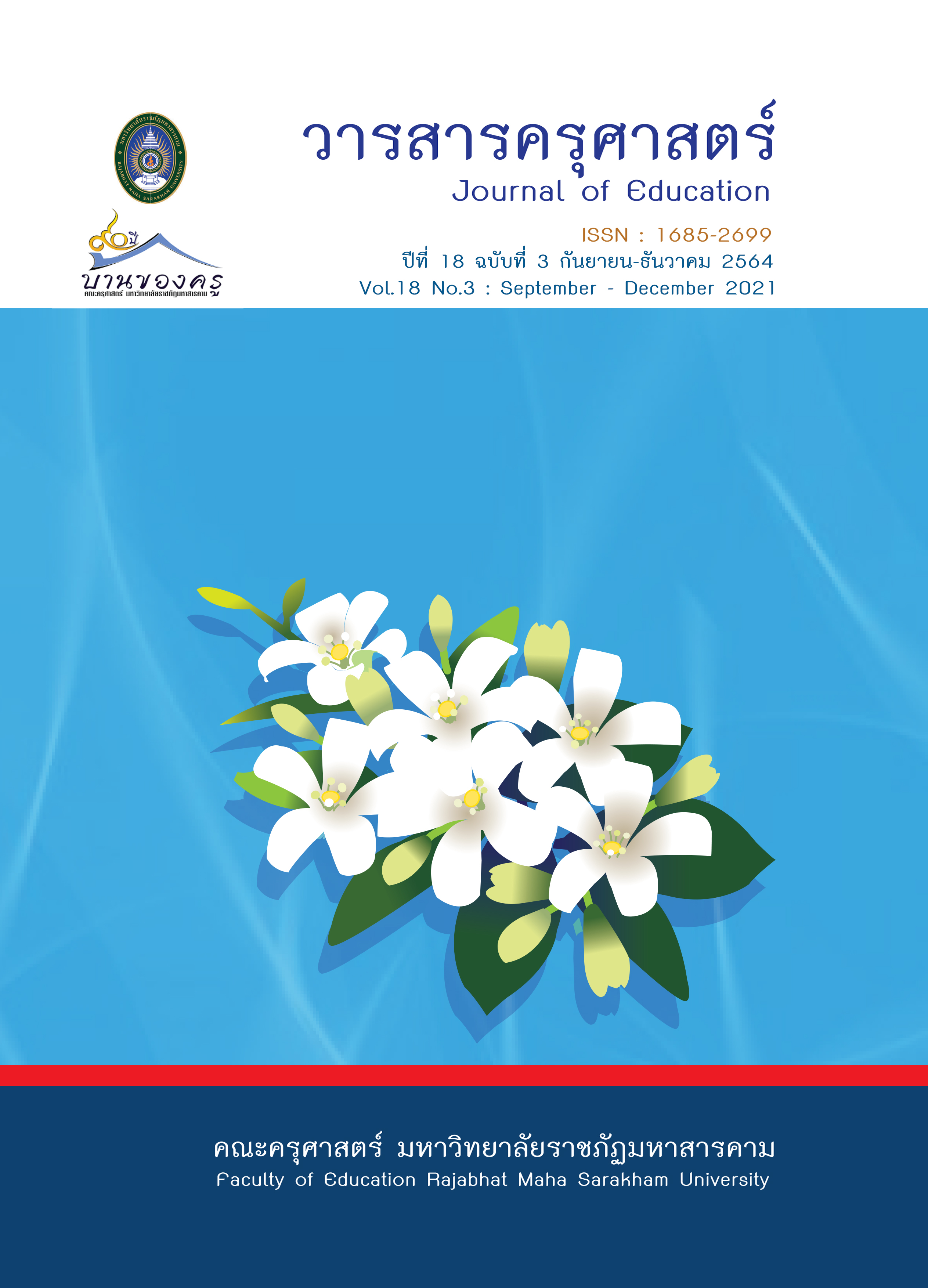Factors affecting the success of Women Football Players’ s Career in Thailand
Main Article Content
Abstract
This research aimed to 1) study factors affecting football player’s career success in Thailand women’s football players, 2) predict the equation of women football player’s career success in Thailand. This study was used quantitative research methodology by conducting among 348 women’s football players to do self-completion questionnaire. The data analysis was analyzed by using percentage, mean, standard deviation, and binary logistic regression analysis. The research results were as follows:
- Five factors affecting women football players’ career success in Thailand were clubs support, intelligence,
decision, social and success indicators.
- Factors affecting the success of Thailand’s women football players can be used to create the measure of success in the careers of women football players in Thailand and create an equation for predicting career success in women football players in Thailand. The prediction of career success was 77.6% correct and the forecast equation was as follows:
Article Details

This work is licensed under a Creative Commons Attribution-NonCommercial-NoDerivatives 4.0 International License.
ข้อกำหนดเบื้องต้นที่ผู้นิพนธ์(ผู้ส่งบทความ) ควรทราบ
1. ผู้นิพนธ์ที่ประสงค์จะลงตีพิมพ์บทความกับวารสาร ตั้งแต่เดือนมกราคม 2563 เป็นต้นไป ให้ใช้รูปแบบใหม่ (Template 2563) โดยสามารถดูตัวอย่างได้ที่เมนู GUIDELINES
2. จะตีพิมพ์และเผยแพร่ได้ ต้องผ่านการประเมินจากผู้ทรงคุณวุฒิ (Peer Review)
3. การประเมินบทความโดยผู้ทรงคุณวุฒิ (Peer Review) เป็นแบบ Double Blind
4. การอ้างอิงบทความใช้หลักเกณฑ์ APA (American Psychological Association) คลิก
5. บทความถูกปฏิเสธการตีพิมพ์ ไม่ผ่านการประเมิน ผู้นิพนธ์ขอยกเลิกเองหรือชำระเงินก่อนได้รับการอนุมัติ ทางวารสารไม่มีนโยบายการคืนเงิน
References
กนกวรรณ กุลชาติชัย. (2545).ความสัมพันธ์ระหว่างลักษณะการบังคับบัญชากับความสำเร็จในงานและผลสำเร็จในธุรกิจของผู้บริหารธุรกิจก่อสร้างในเขตภาคเหนือตอนบน. (วิทยานิพนธ์ปริญญามหาบัณฑิต สาขาวิชาจิตวิทยาอุตสาหกรรมและองค์การ ไม่ได้ตีพิมพ์). มหาวิทยาลัยเชียงใหม่.
ชาญวิทย์ ตั้งสุวรรณกุล. (2554,12 ตุลาคม 2558). ทฤษฎีพฤติกรรมตามแผน ( Theory of Planned Behavior : TPB).https://www.gotoknow.org/posts/470622.
ณรงค์วิทย์ แสนทอง. (2545). คู่มือการพัฒนาระบบการบริหารผลงานยุคใหม่. เอช อาร์เซ็นเตอร์.
เดชา เดชะวัฒนไพศาล. (2543). Competency-based Human Resource Management. วารสารบริหารฅน, 21(4)
ปกรณ์ วงศ์รัตนพิบูลย์. (2550, 7 เมษายน 2558). คุณลักษณะเด่นของผู้ประสบความสำเร็จ 10 ประการ. http://www.entraining.net/article01_success.php.
พระราชบัญญัติส่งเสริมกีฬาอาชีพ.(2556). ราชกิจจานุเบกษา.เล่มที่ 130
วิสาลักษณ์ ชัววัลลี. (2538). การรับรู้ความสามารถของตนเองในเรื่องอาชีพ: ตัวแปรที่น่าสนใจในการศึกษาเกี่ยวกับอาชีพ และการทำงาน. วารสารจิตวิทยา.2(2), 97-109.
ศิริรัตน์ พิริยธนาลัยและจุฑา เทพหัสดิน ณ อยุธยา. (2553). สมรรถนะ เข้าใจ ใช้เป็น เห็นผล. บริษัท ซิกเนเจอร์ โซลูชั่นส์ จำกัด.
สมบัติ หิรัญกิตติ. (2539). องค์การและการจัดการ. วิสิทธิ์พัฒนา.
สมาคมกีฬาฟุตบอลแห่งประเทศไทย. (2560,7 เมษายน 2563). แผนพัฒนาแม่บทฟุตบอลไทยระยะยาว 20 ปี. http://fathailand.org/news/2156
สุทธิชัย ปทุมล่องทอง. (2551). คิดบวก พลังสร้างความสำเร็จ. บริษัท ไทยควอลิตี้บุ๊ค.
สายธาร ไกรขุนทศ. (2543). ปัจจัยที่พยากรณ์ผลการปฏิบัติงานของพนักงานสายการผลิตโรงงานอุตสาหกรรมผลิตอุปกรณ์อิเล็กทรอนิกส์.(วิทยานิพนธ์ปริญญามหาบัณฑิต สาขาวิชาจิตวิทยาอุตสาหกรรมและองค์การ, ไม่ได้ตีพิมพ์) มหาวิทยาลัยเชียงใหม่.
สำนักงานคณะกรรมการข้าราชการพลเรือน (2548,31 มกราคม 2548). การปรับใช้สมรรถนะในการบริหารทรัพยากรมนุษย์.เอกสารประกอบการสัมมนา เรื่อง สมรรถนะของข้าราชการ. สำนักงานข้าราชการพลเรือน
หนังสือพิมพ์ไทยรัฐออนไลน์. (2563, 20 ตุลาคม 2563). สมาคมบอลจัดบอลลีกหญิง ไทยวีมนส์ลีก ตั้งเป้าสร้างฐานไปบอลโลก 2023. https://www.thairath.co.th/sport/thaifootball/changsuek/1957541
หนังสือพิมพ์ไทยรัฐออนไลน์. (2564, 2 มีนาคม2564). ชบาแก้ว U20 แบโผ 30 แข้ง เตรียมลุยศึกชิงแชมป์เอเชีย รอบคัดเลือก. https://www.thairath.co.th/sport/thaifootball/changsuek/2042031
อิษฎี กุฎอินทร์ อาชวิทธิ์ เจิงกลิ่นจันทน์ พรชัย ตรัสใจธรรม และณกุล นาคสุวรรณ. (2559, 7 มิถุนายน 2564). แผนพัฒนาแม่บทฟุตบอลไทยระยะยาว 20 ปี.http://fathailand.org/news/2156
อาชวิทธิ์ เจิงกลิ่นจันทน์. (2561). “การวิเคราะห์องค์ประกอบที่ส่งผลต่อความสำเร็จในอาชีพนักกีฬาฟุตบอลอาชีพของประเทศไทย” วารสารวิทยาศาสตร์การกีฬาและสุขภาพจุฬาลงกรณ์มหาวิทยาลัย, 19 (2),109-120.
อุกฤษณ์ กาญจนเกตุ. (2543). การใช้ Competency ในการบริหารงานบุคคล. วารสารบริหารฅน, 21(4), 19-22.
Adams, G. A., King, L. A., & King, D. W. (1996). Relationships of job and family involvement, family social support, and work–family conflict with job and life satisfaction. Journal of Applied Psychology, 81(4), 411–420. https://doi.org/10.1037/0021-9010.81.4.411
Ajzen, I. and M. Fishbein. (1980). Understanding Attitudes and Predicting Social Behavior. Prentice-Hell.
Ajzen, I. (1991). The theory of planned behavior. Organizational Behavior and Human Decision Processes. 50, 179-211
Arnauld D. N. (2003). Vocational Education and Training in France: From Practice: Case Study of a Curriculum to Theory: General Evolution of Needs. 3th Five year Development Plan, Experts ‘meeting, April 6th-9th, 2003. SEAMEO VOCTECH.
Bass, B. M. (1981). Stogdill’s Handbook of Leadership. The Free Press.
Bandura, A. (1986). A Social Foundation of Thought and Action. A Social Cognitive Theory. Prentice-Hell.
Berry, J. M. (1987). “A Self-Efficacy Model of Memory Performance”. Paper presented at the American Psychological Association meetings,
Blau, G. J. (1988). Further exploring the meaning and measurement of career commitment. Journal of vocational behavior, 32(3), 284-297.
Boam, R. and P. Sparrow. (1992). Designing and Achieving Competency. McGraw-Hill, Reading.
Boyatzis, R.E. (1982). Competence at Work. In a Stewart, Motivation and Society. Jossey-Bass.
Branden, N. (1981). The Psychology of Self-Esteem. 15th Ed. Bantam Book's Inc.
Brooks, R.B. (1992). “Self-Esteem During the School Years,” Pediatric Clinics of North America.
Bruno, F.J. (1983). Adjustment and Personal Growth: Seven Pathway. 2nd Ed. John Wiley & Sons.
Daniel J. O’Rourke, Ronald E. Smith, Frank L. Smoll, and Sean P. Cumming. 2014. “Relation of Parent-and Coach-Initiated Motivational Climates to Young Athletes’ Self-Esteem, Preformation Anxiety, and Autonomous Motivation: Who is more influential” Journal of Applied Sport Psychology, 26:4, 395-408.
Gattiker, U.E. and L. Larwood, 1986. “Subjective Career Success: a Study of Managers and Support Personnel”. Journal of Business and Psychology. 1(2), 78–94
Judge, T. A., Cable D.M., Boudreau J.W., and Bretz, Jr. R.D. 1995. “An empirical investigation of the predictors of executive career success”. Personnel Psychology, 48, 485-519


